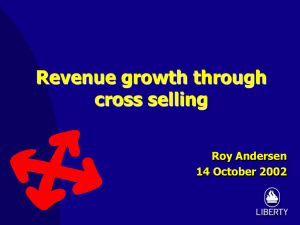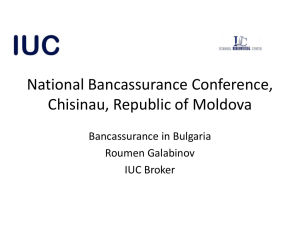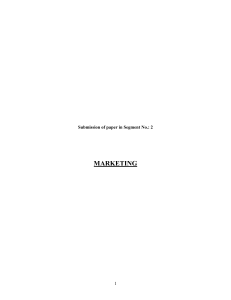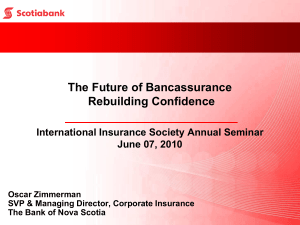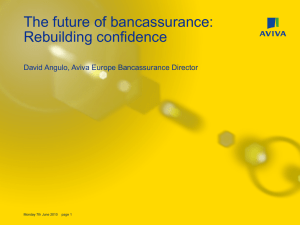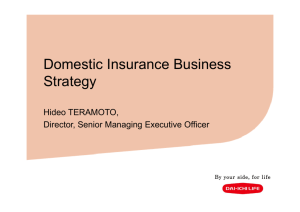Introduction
advertisement
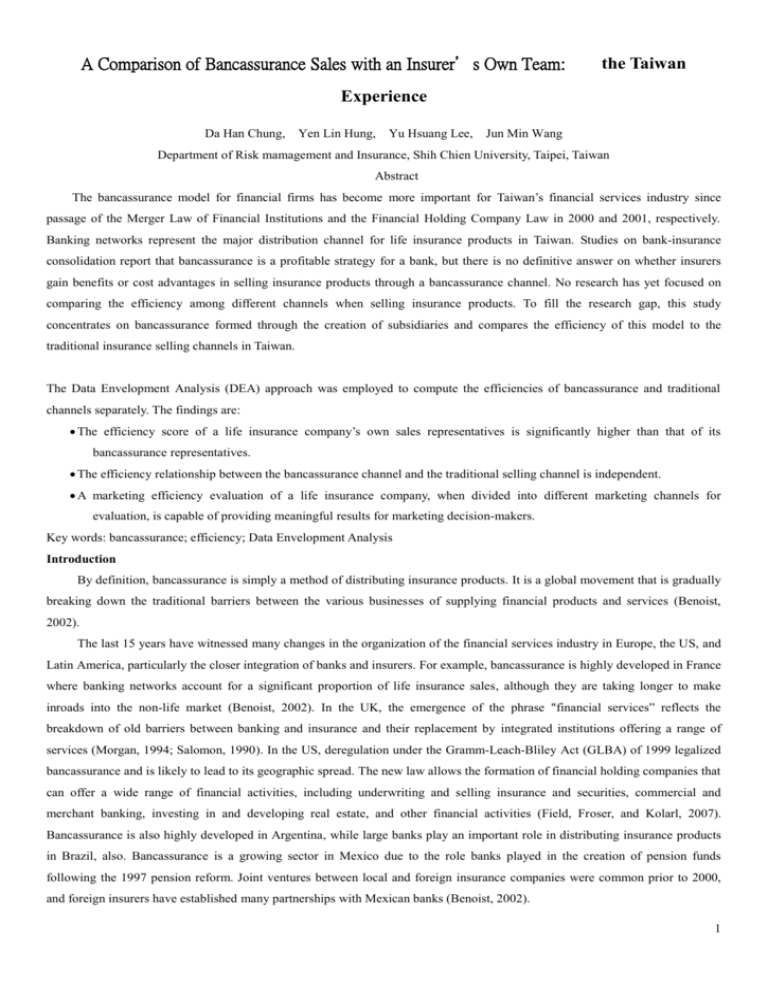
A Comparison of Bancassurance Sales with an Insurer’s Own Team: the Taiwan Experience Da Han Chung, Yen Lin Hung, Yu Hsuang Lee, Jun Min Wang Department of Risk mamagement and Insurance, Shih Chien University, Taipei, Taiwan Abstract The bancassurance model for financial firms has become more important for Taiwan’s financial services industry since passage of the Merger Law of Financial Institutions and the Financial Holding Company Law in 2000 and 2001, respectively. Banking networks represent the major distribution channel for life insurance products in Taiwan. Studies on bank-insurance consolidation report that bancassurance is a profitable strategy for a bank, but there is no definitive answer on whether insurers gain benefits or cost advantages in selling insurance products through a bancassurance channel. No research has yet focused on comparing the efficiency among different channels when selling insurance products. To fill the research gap, this study concentrates on bancassurance formed through the creation of subsidiaries and compares the efficiency of this model to the traditional insurance selling channels in Taiwan. The Data Envelopment Analysis (DEA) approach was employed to compute the efficiencies of bancassurance and traditional channels separately. The findings are: The efficiency score of a life insurance company’s own sales representatives is significantly higher than that of its bancassurance representatives. The efficiency relationship between the bancassurance channel and the traditional selling channel is independent. A marketing efficiency evaluation of a life insurance company, when divided into different marketing channels for evaluation, is capable of providing meaningful results for marketing decision-makers. Key words: bancassurance; efficiency; Data Envelopment Analysis Introduction By definition, bancassurance is simply a method of distributing insurance products. It is a global movement that is gradually breaking down the traditional barriers between the various businesses of supplying financial products and services (Benoist, 2002). The last 15 years have witnessed many changes in the organization of the financial services industry in Europe, the US, and Latin America, particularly the closer integration of banks and insurers. For example, bancassurance is highly developed in France where banking networks account for a significant proportion of life insurance sales, although they are taking longer to make inroads into the non-life market (Benoist, 2002). In the UK, the emergence of the phrase "financial services” reflects the breakdown of old barriers between banking and insurance and their replacement by integrated institutions offering a range of services (Morgan, 1994; Salomon, 1990). In the US, deregulation under the Gramm-Leach-Bliley Act (GLBA) of 1999 legalized bancassurance and is likely to lead to its geographic spread. The new law allows the formation of financial holding companies that can offer a wide range of financial activities, including underwriting and selling insurance and securities, commercial and merchant banking, investing in and developing real estate, and other financial activities (Field, Froser, and Kolarl, 2007). Bancassurance is also highly developed in Argentina, while large banks play an important role in distributing insurance products in Brazil, also. Bancassurance is a growing sector in Mexico due to the role banks played in the creation of pension funds following the 1997 pension reform. Joint ventures between local and foreign insurance companies were common prior to 2000, and foreign insurers have established many partnerships with Mexican banks (Benoist, 2002). 1 The bancassurance model for financial firms has become more important for Taiwan’s financial services industry since passage of the Merger Law of Financial Institutions and the Financial Holding Company Law in 2000 and 2001. Based on these two laws, insurance companies, banks, and securities firms can affiliate under common ownership and cross-sell financial products and services to existing and potential customers. Another reason for the progress of bancassurance business in Taiwan is the “over-banking” problem. Banks were owned mostly by the Taiwan government before 1991 (Chen and Yeh, 1998). Due to private local and foreign banks entering the Taiwan market after the Commercial Bank Establishment Promotion Decree in 1991, the banking environment changed substantially. The Decree, which acted as a deregulation trigger, set off the over-banking problem. In order to eliminate the over-capacity and diseconomies from over-banking, other non-traditional businesses, such as bancassurance, became the new trend in Taiwanese bank operations. But in order to enter the insurance market rapidly and build marketing channels cost-effectively, new insurance entrants followed the bancassurance strategy. The banking industry in Taiwan has experienced tremendous change and increased growth in earnings from insurance products. Banking networks represent the major distribution channel for life insurance products. According to a report by the Financial Supervisory Commission of the Republic of China, bancassurance accounted for 34.41 percent of total first year life insurance premium income in Taiwan as of 2007, behind insurance companies’ own sales teams’ revenue of 60.17 percent but ahead of brokers and general agents at 3.76 percent. The number of insurance sales representatives employed by agencies and brokerages tripled to about 142,000. The increased number of agencies and brokerages affiliated with banks account for 70 percent of all new entries. The growth rate of insurance premiums from these banking agents now exceeds that from traditional underwriters of insurers. Before 2002, the model of an insurance selling channel was “leveraged life distribution,” where the life insurance company took the lead in the channel (Flur, Huston, and Lowie, 1997). The main protagonist under this scenario was a large life insurance company with a range of effective distribution channels, including insurance companies, their own sales representative, general agencies, and independent agencies or brokerages. According to the data reported by the Taiwan Insurance Institute (TII), from 1995 to 2001 less than 1.5 percent of total premium income came from agencies and brokerages. The remaining premiums were earned through insurance companies’ own sales representatives. After deregulation and bancassurance emerged in 2002, the primary model of insurance selling channel in Taiwan changed to leveraged bank distribution. This model requires a large bank with a range of effective distribution channels, including branches, mail, phone, ATMs, and a trust sales force. Even though deregulation has effectively removed the restrictions on combining banking and insurance, banks in Taiwan are prohibited from directly distributing insurance products over their branch network. Insurance companies are not permitted to offer banking activities directly in insurance companies either. However, according to the report of the Financial Supervisory Commission in 2007, over 80 percent of banks formed alliances with insurance agencies or brokerages and usually have 100 percent ownership of their agency or brokerage subsidiaries. The bancassurance business practices of Taiwanese banks clearly differ from those of universal-type financial firms that provide a range of financial products or services within the same firm. Bancassurance activities can be formed by several corporate strategies of banks and insurance companies. According to the OECD (1992), for banks the main structural operations for bancassurance may take the form of minority or majority holdings, full-fledged acquisition, creation of subsidiaries, or joint ventures with holding companies. Due to the importance of bancassurance mergers to both the European and the American financial systems (Fields, Froser, Kolarl, 2007), most studies deal with bancassurance formed through mergers and acquisitions (M&A) and transactions (e.g., Carow, 2001; Fields, Froser, Kolarl, 2007; Boubakri, Dionne, Tri Ki, 2008). Few researchers have explored efficiency in alternative structural operation strategy where bancassurance products from a bank subsidiary are considered in-house products (OECD, 1992) (see Figure 1). 2 Prior empirical studies mainly evaluate the efficiency of bancassurance in banks independently. Mckillop, Glass, and Morikawa (1996) investigated the cost efficiency of large Japanese banks and found that different cost function specifications led to different results. Bergendahl (1995) claimed that the economic reasons for banks selling multiple products include efficiently using fixed capacity resources, customer demand for several products from a single channel, and product combination strategy. No research has yet compared the efficiency between different insurance product channels. To fill this research gap, this study focuses on the bancassurance model formed through creation of subsidiaries and compares the efficiency of this model to that of traditional insurance channels in Taiwan. This study employed the Data Envelopment Analysis (DEA) approach to compute the efficiencies of bancassurance (through creation of subsidiaries) and traditional channels (through an insurer’s own sales representatives) separately. The empirical results confirm the efficiency of both bancassurance channels through subsidiaries and traditional selling through an insurer’s own sales representatives in Taiwan. By comparing the efficiency between these two different insurance selling channels, the marketing decision-maker in life insurance companies can make a more informed choice of selling channel Literature Review Background on Efficiency Measurement Management defines efficiency (or cost-efficiency) either as a characteristic of organizational outputs (“effectiveness”, ‘equity”, “quality”, etc) or inputs (“economy”, “cost”) or as a relationship between outputs and inputs (Meimand, Cavana, and Laking, 2002). In each case, efficiency can be viewed as a transformation ratio: “what has been produced or the value of what has been produced per unit of what has been consumed, or the value of what has been consumed in the process of production” (Kao and Hwang, 2007). The efficiency measurement has been applied to numerous fields over the past few years, including marketing (e.g., Keh, Chu, and Xu, 2006; Wu, 2003), athletic (e.g., Garcia-Sanchez, 2007), technology (e.g., Jerzmanowski, 2007), information systems (e.g., Gebauer and Schober, 2006; Philip, 2007), public policy (e.g., Durlauf, 2005; Vine, Hamrin, Eyre, Crossley, Maloney, , and Watt. 2003), banking efficiency (e.g., McCune, 2007; Yao, et al. 2007), bancassurance, and even insurance. The Efficiency of Bancassurance Many studies of bancassurance focused on benefits or enhanced value in bank-insurance consolidation. Bergendahl (1995) claimed that the economic reasons for banks selling multiple products include efficiently using fixed capacity resources, customer demand for several products from a single channel, and product combination strategy .In contrast, early research findings of Baumol, Panzar, and Willing (1982) implied that there was no benefit from bank-insurance consolidation for existing insurance companies. But Diamond (1984) proposed that spanning both short-term and long-term liability/asset structures in the financial intermediation process and attracting and keeping individual customers and corporate clients better make bank-insurance consolidation beneficial to both insurers and banks. Other studies of the effect of bank expansion into non-traditional industries mainly focus on the risk reduction and value enhancement effects of bank consolidation (e.g., Hughes, Lang, Mester, and Moon, 1999; Carow, 2001; Mamun, Hassan, and Maroney, 2005). Saunders and Walter (1994) and Hughes, Lang, Mester, and Moon (1999) show that bank consolidation is consistent with risk reduction. Felgren (1985) argued that banks had greater cost advantages in selling insurance products than insurance companies because of offices and so forth. Carow (2001) found that bank 3 stock prices after bank entry into the insurance industry do not change significantly. Most early research results about bancassurance agreed that banks gained benefits or cost advantages in bank-insurance consolidation, but the findings were not consistent when they looked at insurers’ benefits from the bancassurance. The studies on bank-insurance consolidation revealed no consensus on whether bancassurance would be a profitable strategy to an insurance company. There were also many studies on the efficiency of insurance companies which evaluated the performance of various insurance business activities. The Efficiency of Insurers Many studies employed the traditional Data Envelopment Analysis (DEA) to explore the efficiency of insurers’ business activities (see Figure 2). Pree and Chauncey (1995) utilized the DEA to help insurance companies monitor and control legal service and costs. Cummis, Tennyson, and Weiss (1999) used the DEA to examine the relationship among mergers and acquisitions, efficiency, and economies of scale in the US life insurance industry over the period 1988-1995. They found that acquired firms achieve greater efficiency gains than firms that have not been involved in mergers or acquisitions. Lin (2002) applied the DEA to measure efficiency scores and to examine whether life insurers in Taiwan have fully recognized the new market structure after deregulation. Results showed no change for overall efficiency, no pure technical efficiency change, and no scale efficiency change after deregulation. Mahlberg and Url (2003) analyzed a panel of Austrian insurance companies over the period 1992 through 1999 to assess the response to the challenges of the single market for the insurance industry by means of the DEA. Their efficiency measure is likely to identify such insurance companies as inefficient compared to other companies, although these companies may offer favorable terms to consumers. Tone and Sahoo (2005) applied the DEA model to examine the performance of the Life Insurance Corporation of India and found a significant difference in the cost efficiency scores over the period 1994-2001. Brockett et. al. (2005) used the DEA coupled with distribution-free rank-order statistics to study the relative efficiency of the different organizational structures used by US property and liability insurance companies. Meimand, Cavana, and Laking (2002) described a modified DEA process to solve the problem of assessing relative branch performance in the Accident Compensation Corporation, the New Zealand state-owned, no-fault, personal injury compensation insurance company. The factors in their DEA inputs were rehabilitation and compensation costs and number of full-time cases and claims managers in the branch. On the output side, the factors included right the first time, number of claimants managed starting each month, number of claimants starting each month expected to have left in less than 12 months, and number of weekly compensation payments meeting the target dates. Yao, Han, and Feng (2007) used a panel data set of 22 insurance companies over the period 1999-2004 to evaluate their efficiency by applying a DEA approach. In their study, labor and capital were input factors while premium, benefits and claims costs were output factors to measure the efficiency of insurance companies. Similarly, by using the DEA approach, Jeng et al. (2007) examined the efficiency changes of US life insurers before and after demutualization in the 1980s and 1990s. The inputs used in their model were labor, business service, eEquity cost, assets and underwriting and investment expenses. On the output side, the factors included benefit payments and return on assets. To gain valuable managerial insights for insurers, the latest studies used a modified DEA approach to evaluate the efficiency 4 of an insurance company. Hwang and Kao (2006) and Kao and Hwang (2007) modified the conventional DEA by taking into account the series of relationships of the two sub-processes within the whole process (see Figure 3). The relational model developed in their papers was more reliable in measuring the efficiencies and could identify the causes of inefficiency more accurately. The inputs used in the first stage are operating expense and insurance expense. The outputs of the system, which were also the outputs of the second stage, are underwriting profits and. investment profits. There were also two intermediate products in the system, which were the outputs of the first stage as well as the inputs of the second stage: direct written premiums and reinsurance premiums. Wu et al. (2007) and Yang (2005) employed a two-stage DEA approach to assess production and investment efficiency simultaneously for the Canadian life and health insurance industry. This model allowed integration of the production and investment performance for the insurance companies, provided management with an overall performance evaluation and suggested how to achieve efficiency systematically for the insurers involved. The input factors in their DEA model were labor expense, general operating expense, capital equity and claims incurred. The outputs were net premiums written and net income. Summary of Literature Review Previous studies of bank-insurance consolidation reported that bancassurance is a profitable strategy to a bank, but there is no consensus on whether insurers gain benefits or cost advantage in selling insurance product through bancassurance channels. Early studies on the efficiency of insurance, no matter what stage they evaluated, did not focus on insurance marketing channels, nor did they mention the efficiency comparison between direct and indirect marketing channels (see Figure 4). 5 The inputs and outputs used for evaluating the efficiency of insurance companies in prior studies are reported in Table 1. Accordingly, this study selects some appropriate inputs and outputs to assess the efficiency of traditional selling channels and bancassurance channels Table 1: The Inputs and Outputs Used for Evaluating the Efficiency of Insurance Companies Methodology The DEA Methodology According to the concept of efficiency for the performance evaluation method, the main comparison is between input-output relations. The DEA efficiency assessment model used envelope line technology to replace the general economics of individual production function, whose basic theory was based on Farrell’s work (1957) on the concept of technical efficiency. Three scholars (Charnes, Cooper and Rhodes,1978) expanded the single input single output model to the concept of multiple inputs-multiple outputs, creating a form to assess the decision-making units’ relative efficiency. This can use non-identical units for a number of inputs and outputs various renovation to a single value, which was obtained for a value prefecture institutions organizational efficiency, commonly known as CCR model. This study used the CCR model to measure the decision-making units’ (DMU) operating efficiency. The theoretical description follows: 6 Charnes et al. (1978), following Farrell (1957), assessed the efficiency of the theoretical basis, through two inputs, the outputs of a single model, and expand to multiple inputs and multiple outputs model, the fixed pay scale under the assumption that using linear programming method, the production border, and to assess each unit for the relative efficiency, the law is known as the DEA model CCR. Suppose k DMUs, each DMU k(k=1,⋯ ,N), using the m input species ik (i=1,⋯,m;k=1,⋯,N)>0, production n outputs y rk (r=1,⋯,s;k=1,⋯,N)>0, as can be in a DMU k expected that the efficiency values are : n u y r Max Hk = rk r=1 m v i ik i=1 n u y r subject to Hk = rk r=1 m v i 1 (1) ik i=1 y rk :amount of the r th output for the k th DMU; ik :amount of the i th input for the k th DMU; u r :the weight assigned to the r th output; v i :the weight assigned to the i th input; : Non-Archimedean Quantity, is arbitrary small positive values Because the scores-planning (Fractional Programming) model is not easy to solve, Charnes et al., (1978) converted it to the linear programming (Linear Programming) model: n H k = u r y rk Max r=1 n subject to m u y - v r rk r=1 i 0 ik (2) i=1 u r ,vi > 0 ; i=1, ,m ; r=1, ,n ; k=1, ,N Formula (2) in the input items portfolio weighted average value of the one cases, the items for output weighted average portfolio maximum efficiency is used to indicate the relative value. But its limitations - the number (n + k + m + l) - was significantly more than the number of variables (n + k), can use dual conversion pairs (duality) mode, reducing restrictions on the number of convenience-type solution, as follows: n m Min H k = k - Sik- + Srk+ r=1 i=1 N subject to k ik - k ik +Sik- =0 k=1 N k 1 k 1 N k ik -Srk+ = y rk (3) k=1 , k , Sik- , Srk+ 0 ; i=1, - + Formula (3) Sik , Sik and ,m ; r=1, ,n ; k=1, ,N, unconstrained k for all DMU and the best allocation of DMU combination of linear equations, the weights θ - + efficiency of a practical value. Sik and Sik are the input and output variables variance, the representative of the actual value and the best efficiency of the difference between the value that can be used to understand the inputs and outputs of the number of 7 - + rooms for improvement. When θ = 1, Sik = Sik = 0, the DMU stayed relatively efficient. When DMU relative efficiency, and can be adjusted through the following and achieving optimum efficiency goals: ik* = k* ik -Sik-* y*rk =y rk +Srk+* (4) Defining Input- Output Factors in DEA Model The input-output factors used in this paper are in Table 2. Results and Conclusions Based on (2) and (3), an evaluation of input-output information published in the “Life Insurance Review of Republic of China” by the Taiwan Insurance Institute (TII) was conducted. The input-output data of traditional selling channels and bancassurance channels are shown in Tables 3 and 4. Results, including efficiency scores and rankings of the traditional selling channels and the bancassurance channels evaluated by the DEA method, are shown in Table 5. 8 9 There are nine life insurance companies that are relatively efficient in traditional selling channels: Global Life, ING Life, Life Insurance Dept. of CTC, China Life, Shin Kong Life, Global Life, Sinon Life, Singfor Life, and Allianz President Life. The two life insurance companies which are relatively efficient in bancassurance channels are Cathey Life, and Allianz President Life. Some life insurance companies such as Global Life, ING Life, and Singfor Life, may be relatively efficient in traditional selling channels but perform poorly in bancassurance channels. Cathey Life is the only life insurance company that performs relatively efficiently in bancassurance channels but poorly in the traditional selling channels. There are six life insurance companies that perform equally poorly in both the traditional and bancassurance channels: New York Life, Manulife Limited (Taiwan Branch), Nan Shan Life, MassMutual Mercuries Life, and Hontai Life. The only life insurance company that performs relatively efficiently in both traditional and bancassurance channels is Allianz President Life. 10 The researchers conducted the Mann-Whitney U test and the Spearman Rank Correlation test to determine whether there is a significant difference between inefficiency score and rank between traditional and bancassurance channels. Table 6 shows that there is a significant efficiency score difference between the traditional and the bancassurance marketing channels (U = 87.00, p = 0.001 < 0.05). The efficiency mean of the traditional channel is higher than that of the bancassurance channel. Table 7 shows the Spearman’s Rank correlation statistics, which indicate that there is no efficiency rank relationship for the 21 life insurance companies between the bancassurance and the traditional channels (p = .170 > 0.05). Table 6: Mann-Whitney U Test of Efficiency Comparison in the Traditional Selling and Bancassurance Channel Efficiency Score Mean Std. Dev. Mann-Whitney U (p-value) Traditional Selling Channel 0.7620 0.26038 87.000 Bancassurance Channel 0.4198 0.32835 (0.001) Table 7: Spearman’s Rank Correlation Coefficients of Efficiency in the Traditional Selling and the Bancassurance Channel Traditional Selling Channel – Bancassurance Channel Spearman's rho .311 p-value .170 The Mann-Whitney U test (see Figure 5) and the Spearman Rank Correlation test (see Figure 6) indicate that the efficiency of traditional selling channels is significantly higher than that of bancassurance channels. The efficiency rank of traditional selling channels was independent of the bancassurance channel. In other words, there is no efficiency rank relationship between a life insurance company’s own sales representatives and its bancassurance representatives in Taiwan. Managerial Implications This study suggests four managerial implications: 1. The efficiency score of a life insurance company’s own sales representatives is significantly higher than that of its 11 bancassurance representatives. Companies such as ING Life , Global Life, and Singfor Life should try to improve their bancassurance efficiency by changing the banks they partner with. 2. The efficiency relationship between the bancassurance channel and the traditional selling channel is independent. The life insurance companies that perform better in traditional selling channels may not perform similarly in bancassurance channels. From the viewpoint of insurers, how bancassurance representatives perform has nothing to do with the insurer’s own sales team but it is related to the banks they select. Therefore, to perform better in bancassurance channels, choosing appropriate partner banks becomes the most important factor for most of the life insurance companies in Taiwan. 3. The research findings suggests that a marketing efficiency evaluation of a life insurance company, when divided into different marketing channels for evaluation, can provide meaningful results for decision-makers in determining marketing strategies 4. According to the report of the Insurance Institution of Taiwan (IIT) in 2007, the majority of products sold by insurers’ own sales representatives are life insurance products. The only product that bancassurance representatives prefer to sell is investment-linked insurance. Therefore, whether the efficiency difference in different marketing channels can be attributed to different products sold is a topic for future research.. 12 References Baumol, W. J., Panzar, J. C., and Willig, R. D. (1982). Contestable markets and the theory of industry structure. New York: Harcourt Brace Jovanovich. Benoist, G. (2002). Bancassurance: The new challenges, The Geneva Papers on Risk and Insurance, 27(3), pp.295-303. Bergendahl. G.. (1995). The profitability of Bancassurance for European banks. International Journal of Bank Marketing. 13(1), pp.17-29. Boubakri, N., Dionne, G. , and Triki, T. (2008). Consolidation and Value Creation in the Insurance Industry: the Role of Governance. Journal of Banking and finance, 32, p.p. 56-68. Brockett, P.L., Cooper, W.W., Golden, L.L., Rousseau, J.J., and Wang, Y. (2005). Financial intermediary versus production approach to efficiency of marketing distribution systems and organizational structure of insurance companies. The Journal of Risk and Insurance, 72(3), p.p.393-412 Charnes, A., Cooper, W. W. & Rhoades, E. (1978). Measuring the efficiency of de-cession making units. European journal of operational research 2(6): 429-444. Chen, T. Y. and Yeh, T. H. (1998). Study of efficiency evaluation in Taiwan’s banks, International Journal of Service Industry Management, 9(5), pp.402-415. Carow, K. A. (2001). “The wealth effects of allowing bank entry into the insurance industry”, The Journal of Risk and Insurance, 68(1), p.p.129-150. Cummins, D., Tennyson, S., and Weiss, M. A. (1999). Consolidation and efficiency in the US life insurance industry. Journal of Banking& Finance, 23, pp325- 357 Dimon, D. W. (1984). Financial Intermediation and Delegated Monitoring. Review of Economic Studies, 51, p.p. 393-414. Durlauf, S. N. (2005). Racial Profiling as a Public Policy Question: Efficiency, Equity, and Ambiguity. American Economic Review. 95(2), p132-136. Farrell, M. (1957). The Measurement of Productive Efficiency. Journal of the Royal Statistical Society General 120, Series A, Part 3: 253-281. Felgren, S. (1985). “Bank as insurance agencies: local constraints and competitive advances. Federal Reserve Bank of Boston,” New English Economic Review, pp.34-39. Field, L. P., Froser, D. R., and Kolarl, J. W. (2007). Bidder returns in bancassurance mergers: Is there evidence of synergy? Journal of Banking & Finance, 31(12). Pp.3646-3662. Flur, D. K., Huston, D., Lowie, L. Y. (1997). Bancassurance, The McKinsey Quarterly, 3, pp.126-132. Garcia-Sánchez, I. M. (2007). Efficiency and effectiveness of Spanish football teams: a three-stage-DEA approach. Central European Journal of Operations Research, 15(1), p.p. 21-45. Gebauer, J. and Schober, F. (2006). Information System Flexibility and the Cost Efficiency of Business Processes. Journal of the Association for Information Systems, 7(3), p.p. 122-146. Hwang, S.N., and Kao, T.L. (2006). Measuring managerial efficiency in non-life insurance companies: An application of two-stage data envelopment analysis technique. International Journal of Management, 23, p.p.699-720 Hughes, J. W., Lang W., Mester, L., and Moon, C. (1999). “The dollars and sense of bank consolidation.” Journal of Banking and Finance, 23, p.p.291-324. Jeng, V., Lai, G. C., and McNamara, M. J. (2007). Efficiency and demutualization: Evidence from the U.S. life insurance industry in the 1980s and 1990s, The Journal of Risk and Insurance, 74(3), p.p. 683-711. Jerzmanowski, M. (2007). Total factor productivity differences: Appropriate technology vs. efficiency. European Economic Review, 51(8), .p.p. 2080-2110. 13 Kao, C., and Hwang, S.-N. (2007). Efficiency decomposition in two-stage data envelopment analysis: An application to non-life insurance companies in Taiwan. European Journal of Operational Research, 10, p.p.1-12 Keh, H. T., Chu, S., and Xu, J. (2006). Efficiency, effectiveness and productivity of marketing in services. European Journal of Operational Research, 170(1), p.p.265-276. Lin, L. F.(2002) Deregulation and efficiency in the Taiwan life insurance industry. Temple University. PhD dissertation. Mahlberg, B. and Url, T. (2003). Effects of the single market on the Austrian Insurance industry. Empirical Economics, 28, pp813- 838 Mamun, A., Hassan, M. K., and Maroney, N. (2005). “The wealth and risk effects of Gramm-Leach-Bliley Act (GLBA) on the US banking industry,” Journal of Business Finance and Accounting, 32, pp.351-388. McCune, J. (2007). Efficiency has been flat. Where is it headed? ABA Banking Journal, 99(5), p.14. Mckillop, D. G., Glass, J. C., and Morikawa, y. (1996). “The composite cost function and efficiency in giant Japanese banks, Journal of banking and Finance, 20, p.1651-1671. Meimand, M., Cavana, R.Y., and Laking, R. (2002). Using DEA and survival analysis for measuring performance of branches in New Zealand’ Accident Compensation Corporation. Journal of the Operational Research Society, 53, p.p.303-313 Morgan, G. (1994). Problems of Integration and differentiation in the management of ‘Bancassurance’. The Service Industries Journal, 14(2). pp.153-169. OECD (1992). Insurance and other Financial Service: Structural Trends, The Organization for Economic Cooperation and Development, Paris. Philip, G. (2007). Is Strategic Planning for Operational Efficiency. Information Systems Management, 24(3), p.p. 247-264. Pree, D., Jude, C.D., and Kathryn, R.(1995). A tool to insurance company management assess attorney efficiency and productivity. CPCU Journal, 48(3), p.p.155-162. Salomon, B. (1990). Multinational Money Center Banking. The Evolution of a single European Banking Market. London: Salomon Bros. Saunders, A. and Walter, I. (1994). Universal Banking in the United States: What Could We Gain? What Could We Lose? Oxford University Press, Oxford. Tone, K. and Sahoo, B. K. (2005). Evaluating cost efficiency and returns to scale in the Life Insurance Corporation of India using data envelopment analysis. SocioEconomic Planning Sciences, 39, pp261- 285 Wu, D.,Yang,Z.,Vela,S.and Liang,L. (2007). Simultaneous analysis of production and investment performance of Canadian life and health insurance companies using data envelopment analysis, Computers & Operations Research, 34, pp.180-198 Wu, Z. (2003). Market efficiency in the reformed Chinese grain marketing system. China Economic Review, 14(2), p.p. 115-131. Vine, E., Hamrin, J., Eyre, N., Crossley, D., Maloney, M., and Watt, G. (2003). Public policy analysis of energy efficiency a nd load management in changing electricity businesses. Energy Policy, 31(5), p.p. 405-431. Yang, Z. (2006). A two-stage DEA model to evaluate the overall performance of Canadian life and health insurance companies, Mathematical and Computer Modeling,43, pp.910-919 Yao, S., Han, Z.and Feng, G. (2007). On technical efficiency of China’s insurance industry after WTO accession, China Economic Review, 18, pp.66-86 Yao, S., Jiang, C., Feng, C., and Willenbockel, D. (2007). WTO challenges and efficiency of Chinese banks. Applied Economics, 39(5), p.p. 629-643. 14
